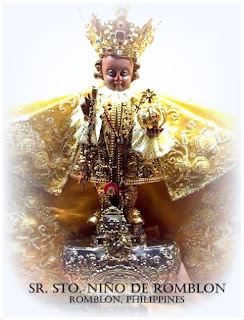Santo Niño de Romblon - Romblon's King and Treasure
 |
| Santo Niño de Romblon |
This miraculous image of the Child Jesus for centuries became part and parcel of the lives of the people of Romblon and it was a great loss of the people when the image was sacrilegiously stolen and after two decades, his return was a grand celebration of the province - this proves the fervent devotion and affection to their beloved King.
 |
| Close up details of the image |
The image of the Santo Niño de Romblon is that of a carved wooden image meant to be vested. The image has a brownish complexion and said to be a replica of the famed Santo Niño de Cebu from the observation of the image's stance and style of carving and the way he was fashioned from the base of the image and its vestments.
History
 Tradition has it that in 1582, the Niño was commissioned by an Augustinian Friar, who had the figure carved in the Philippines, based on the original Sto. Niño de Cebu. The replica image was meant to be shipped to Madrid, but when the galleon carrying the image stopped over at Romblon, a typhoon stopped the ship from leaving. The Sto. Niño was thus taken down from the vessel and brought to the local church where a Holy Mass was offered. After the rites, the Sto. Niño could not be moved from its place, and so the galleon left the image behind. This manifestation shows that the Child Jesus chose this quiet island to grant his protection and graces for those who will ask for them - and the people fervently responded.
Tradition has it that in 1582, the Niño was commissioned by an Augustinian Friar, who had the figure carved in the Philippines, based on the original Sto. Niño de Cebu. The replica image was meant to be shipped to Madrid, but when the galleon carrying the image stopped over at Romblon, a typhoon stopped the ship from leaving. The Sto. Niño was thus taken down from the vessel and brought to the local church where a Holy Mass was offered. After the rites, the Sto. Niño could not be moved from its place, and so the galleon left the image behind. This manifestation shows that the Child Jesus chose this quiet island to grant his protection and graces for those who will ask for them - and the people fervently responded. Miracles
MiraclesFor centuries, the Sto. Niño de Romblon resided at the Cathedral of San Jose and several miracles were attributed to this miraculous image from saving the island from pestilence, typhoons, drought and other calamities, as well as several favors granted that the image became well known and loved by the people of Romblon.
One incident in particular happened during World War 2 where bomber planes couldn’t locate the island from above because the Santo Niño conjured thick clouds to shield Romblon from the eyes of the Japanese pilots. Recently, Romblon Governor Eduardo Firmalo recalls that Romblon was also directly under the path of of the dangerous Super Typhoon Yolanda (Haiyan) but “it suddenly changed course and spared us from destruction because of the protection of their beloved King.
The Biniray Festival
 |
| Biniray Festival |
 The Stealing of the image
The Stealing of the imageIn 1991, the miraculous image was sacrilegiously stolen from His High altar and this left the whole province devastated. The grief of the people was unimaginable for they lost their beloved King and Treasure. A replica was immediately commissioned while Nevertheless, the religious fervor of the people of Romblon continues to burn brighter as years passed by in the hopes of the return of the image to his Kingdom in Romblon.
The Return of the image
After 22 years, the much awaited miracle happened that caused much rejoicing to the people of Romblon. In January 29, 2013, the stolen image of Sto. Niño de Romblon was finally recovered. An antique collector from Kalibo, Aklan, had managed to get hold of it and showed it to a priest from Romblon, who immediately recognized it as the image that had been stolen in 1991 from the Romblon cathedral. To verify its authenticity, the Camarera of the image was called to identify the image and the Camarera positively identify the image for she recognized the features of the image and further confirmed its authenticity.
 |
| The Triumphant Return of Sto. Nino de Romblon |
Without asking for payment, the antique collector turned over the Sto. Niño to Romblon Representative Eleandro Jesus Madrona who brought the image to his house in Quezon City. The lawmaker later brought it to the “Sambugan” festival on Feb. 3 at La Playa Resort in Tanza, Cavite, where Romblonanons gathered to welcome the Sto. Niño.
 |
| St. Joseph's Cathedral in Romblon |
Today, the people of Romblon continued their fervent devotion to the Santo Niño de Romblon that the new generation of Rombolnanons now experience the wonders of their King from cures from different ailments, financial help among others. The Child King continues to shower them graces and protection in return and this bond with his chosen people is inseparable.





Heiliges Jesuskind segne mich AMEN .
ReplyDeleteThank you our beloved Santo Nino for saving us from disaster of tyhoon Yolanda and other calamities!
ReplyDelete